Loading...

Issue 91
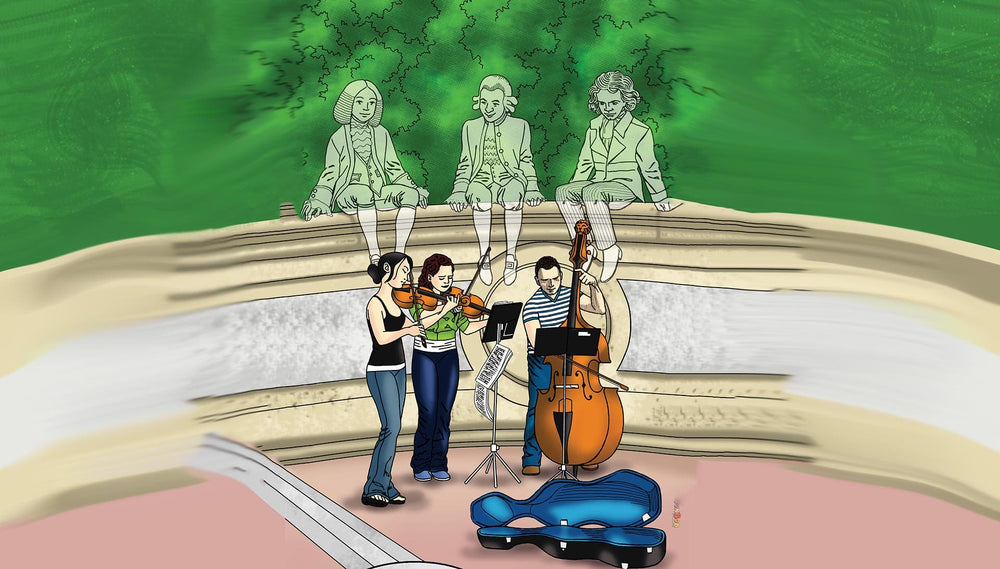
Sounds Good to Me
What attributes should an item of equipment in a sound reproduction chain possess in order to meet the objectives of high-end audio playback? One attribute we tend to think of as important is flatness of frequency response. If a piece of equipment either boosts or attenuates a particular band of frequencies we tend to consider that a big no-no. Departures from a nominally flat frequency response – sometimes even subtle departures – can often be correlated with some sort of perceived tonal coloration in the resultant sound output. So flat frequency response is high on our list of good things, especially with equipment such as amplifiers.
But with loudspeakers the situation becomes horribly convoluted. Loudspeakers don’t even have a simple frequency response. For a start, their output is highly directional. More comes out in the straight-ahead direction than comes out at some angle to the side, or at some angle upwards or downwards. The laws of physics tend to demand that the proportion of the drive unit’s total output which is delivered off-center is strongly frequency dependent. So if, as you might be inclined to do, you measure a speaker’s frequency response in the straight-ahead direction, and optimize all the design variables so that the resultant on-axis frequency response is ruler flat, then the total energy delivered into the room (the sum of the loudspeaker’s outputs in all directions) cannot be flat at all. And vice-versa.
Then there’s the loudspeaker’s interaction with the room. Only a tiny, miniscule proportion of the total sound output of the loudspeaker travels directly from the loudspeaker to your ear. All the rest of it is launched into the room, where it bounces around off the walls and furniture. Some of it doesn’t so much bounce mirror-like, as diffuse like a spotlight shone onto a matte-painted wall. In any case, eventually, some of that dispersed sound also reaches your ears. When all these sounds reach your ears, having taken a plethora of paths to get there, they will recombine. Each of these sounds, depending on the path they have taken, will have a different phase delay, which means that they can constructively or destructively recombine, and the net effect is a somewhat unpredictable and chaotic disturbance to the overall frequency response. And should you move six inches to one side or the other, the net effect can change dramatically.
To a certain extent, you can attempt to correct for these effects by applying room-correction techniques to the signal. Effectively, you pre-distort the signal in such a way that the speaker/room combination exactly compensates for this added distortion and cancels it out completely. This is a complicated topic of its own, but the short answer, if you want one, is that it works really well at low frequencies and really badly at high frequencies.
Other effects, such as the ‘liveliness’ of a room – in effect the propensity of sound to continue reverberating around a room long after the generating stimulus has passed – add further complexities to the picture which cannot be reduced to a simple disturbance of the frequency response.
Another related issue boils down to the question of what a person who listens to something actually hears. What we actually hear is governed quite strongly by the peculiar shapes of our ears. If we hold the empty tube from a used-up kitchen roll to our ears, and listen through it, we hear an obviously colored sound. We would clearly be upset if our loudspeakers sounded like that. And yet that is precisely what our weirdly-shaped ears do. They effectively color the sound in quite a strong manner. Moreover, this coloration changes strongly according to the direction the sound is coming from. In other words, if you turn your head slightly, the coloration (i.e. frequency response) of what you hear will change slightly. Finally, because your ears have a different shape from mine, what you hear in terms of frequency response will be totally different to what I hear.
Now, to be fair, all of this ear stuff is compensated for to a large degree by our brains, which process what our ears detect, and decide what it is we are actually hearing. And the argument is a good one which holds that – over the short term at least – our ears are unchanging, and whatever colorations they might impose upon incoming sounds our brains are able to compensate for. But even so, at least in tests I have conducted upon myself, applying very small frequency response aberrations to a real music signal played through my loudspeakers, it is quite surprising how large a frequency response error has to be in order for it to be unambiguously noticeable. [NB: You can’t perform this test rigorously just by going into iTunes and playing with the graphical equalizer. It is quite a complex problem, in reality.]
So, an interesting question you might want to ask is this. Why, if the frequency response of a loudspeaker in a room is not remotely close to being flat, should it matter a jot that the frequency response of, say, the amplifier feeding it, is not itself ruler flat? Here we get into difficult territory, because there is plenty of anecdotal evidence which supports the truism that the flatter an amplifier’s frequency response, the better it tends to sound.
Before you start throwing things at me, I’m not trying to suggest that any amplifier with a flat frequency response will sound better than any other with a less-flat response. Painting with a broad brush here, the frequency response of just about any non-flat amplifier can be flattened up nicely with, for example, a hefty dose of negative feedback, and as a rule we find that the application of such feedback is normally deleterious to perceived the sound quality.
But it is an interesting observation nonetheless. And the equivalent situation holds for phase response: the phase response of a loudspeaker in a room is also a total mess, yet amplifiers and other electronic circuitry with only minor amplitude or phase response problems are often found to sound notably less satisfactory in real-world systems.
I would add to that digital processing. Low-pass Butterworth filters often sound fractionally better than equivalent Chebyshev filters, and both of these IIR filters tend to sound better than broadly equivalent FIR filters. There I go with the broad brush again, but when you wash away the noise that is the sort of consistent picture that tends to emerge. I will add this, though. At BitPerfect we have a digital processing engine that allows us to separate out the effects of phase and amplitude response, and the picture that emerges quite clearly is that phase response is by far the more important of the two. In an experiment we have prepared filters which produce a mathematically identical frequency response, but with three different phase responses, one of which is totally flat. Most listeners express a clear preference for the totally flat (i.e. totally linear) phase response.
So there is a definite dichotomy which is still in play. When we listen to loudspeakers in a room, we are hearing a sound which, with the best will in the world, is pickled with serious amplitude and phase distortions across the entirety of the audio band. These massively swamp any corresponding distortions that may have been introduced in the amplification chain. I would go so far as to suggest (not having tried it!) that it would be nigh on impossible to even measure the frequency and/or phase responses of an amplifier using microphones to measure the in-room output via the loudspeaker.
Why, then, are those properties of those amplifiers (and, from my personal perspective, digital audio processing chains) so gosh-darned audible?
Paper
It’s everywhere. We take it for granted, blow our noses on it, wipe…. and yet, paper has been a vital part of sound reproduction from the earliest days. Despite the appearance of high-tech, exotic materials, it’s still an important material for loudspeaker cones. In some cases, the old ways are the best.
In the early years of audio, pretty much every method of reproducing sound that can be imagined, had been tried. If you think electrostatic, planar, or plasma loudspeaker drivers are recent innovations—guess again. By the 1920s, all those and many more had been tried, and nearly all were rejected on the basis of nonlinearity, low output, high cost, or even lethality.
The winner by default was the moving coil driver with a paper cone.
As was the case of Mark Twain, the rumors of the paper cone’s demise have been greatly exaggerated. Way back in 1962, audio entrepreneur Irving M. “Bud” Fried wrote “Farewell to the Paper Cone” in an early issue of Stereophile—but there is still a place in the world for the “old-fashioned” variety of speaker cone.
Like it or not, all engineering is a matter of choosing compromises. Fried’s reference to the “turgid, mushy sound” of paper cones was of course a generalization, and of course those words were carefully chosen to highlight by comparison the merits of the bextrene-coned speakers that he happened to sell. Fried was a master wordsmith and marketer, as well as a trained attorney, and he very much had a horse in that race.
Listening to those bextrene-coned speakers now, their characteristic hollow, tubby resonances are readily apparent. They may have been better than the mass-market paper coned small speakers Fried indicts, but they largely swapped one set of problems for another…which is a very human thing to do. Critics refer to the sound as “Tupperware”, which is overstating the case—but it is a vivid, easily-understood characterization.
But what about paper? How can a material that generally has very little strength and no internal rigidity possibly be used to make sound?
First, let’s understand that the paper used in making loudspeaker cones isn’t the same stuff as paper towels, or the ream you cram into your ink-jet printer. From the earliest days of add-on speakers that perched atop a battery radio set, manufacturers tweaked the cone material, experimenting by adding felt, cloth, hemp, all manner of fibrous materials to the pulp mix. You’ll see some cones that look like the construction paper you cut with blunt-nosed scissors in grade school; some look and feel more like common cardboard; still others have a mottled appearance more like handmade fine art material than an industrial product. The light weight of a paper cone was especially important back in the day of flea-powered amps and radio receivers, and continues to make them favorites of aficionados of low-powered SET amps today.
The Stromberg-Carlson speaker was a fairly common unit from the early ’20s. It was designed to set on a table top alongside a radio, or on top of the tabletop radio itself. Several things are immediately apparent: we see a seam where the paper cone was cemented together—later speaker cones were generally press-formed on an internal or external screen, to provide a seamless cone. From the perspective of most cone drivers, this is back-to-front, with the center point of the cone being the closest point to the listener, rather than the farthest. You’ll also notice that there is no dust cap in the center of the cone—and that’s because this particular speaker was driven by a lever arrangement attached to the brass cap or ferrule seen in the center. Most speakers of the era were of the field coil/electromagnet variety, but this one has a horseshoe permanent magnet.
By the way, this particular speaker is not small—it’s about 16″ in diameter, and I would assume that it’s fairly hefty, given the large cast metal base and frame.
I can’t even look at that large, exposed cone without getting the willies. In high school I owned a 1936 Philco floorstanding cathedral radio (bought for $12, thank you), and while tightening a connection with a screwdriver on the back of the set, slipped and punched a neat hole in the 15″ paper cone. While not a fatal error—mending with Scotch tape didn’t noticeably alter the sound—it gave me an appreciation of how easily paper cone drivers could be damaged.
The cone shape itself has multiple functions. Shaping the paper into a cone provides structural strength and rigidity, compared to that of a flat sheet of paper. It also moves a greater volume of air compared to a flat surface, and provides mechanical leverage, increasing the velocity of the air it moves. The cone form also provides some of the acoustical transformer effect which horns provide, more effectively coupling the driver to the air.
Further strength and acoustical adjustments can be provided by reinforcing the cone with concentric or radial ribs. In the most extreme example of this, the coaxial full-range (and you know that that term really means “we tried to cover everything with one driver, and mostly did it”) RCA LC-1 designed by the legendary Harry F. Olson (who has been mentioned more than once in these columns) was originally manufactured with a pretty conventional, lightly-ribbed cone. Subsequent versions (LC-1A, -B, and -C) featured added-on conical domes and a two-piece center deflector or “butterfly” which acted to diffuse the sound and prevent beaming. Presumably, the conical add-ons strengthened the cone, and given Olson’s expertise, the additional mass must have been useful, for some reason.
 I am admittedly a materials nerd, and can happily spend hours searching websites of companies like Kurt Müller, which provides cones, domes, and diaphragms for many prominent speaker manufacturers. Given the time and resources, I'd also happily research and document the types of paper and other materials used in loudspeakers. This piece has barely scratched the surface of the topic of paper cones---but I hope it has punched a hole in the myth that paper cones are obsolete. ;->
I am admittedly a materials nerd, and can happily spend hours searching websites of companies like Kurt Müller, which provides cones, domes, and diaphragms for many prominent speaker manufacturers. Given the time and resources, I'd also happily research and document the types of paper and other materials used in loudspeakers. This piece has barely scratched the surface of the topic of paper cones---but I hope it has punched a hole in the myth that paper cones are obsolete. ;->
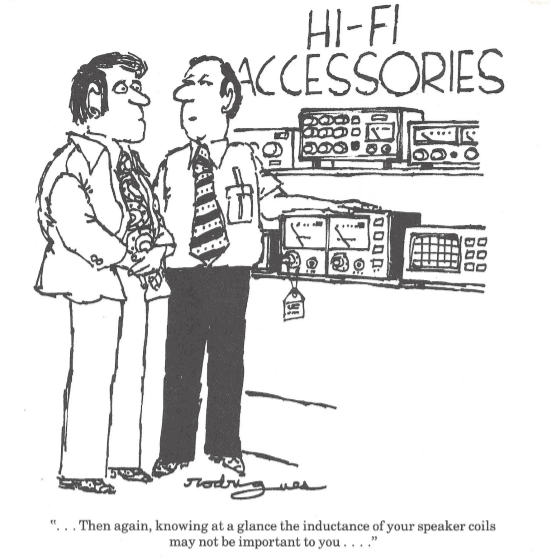
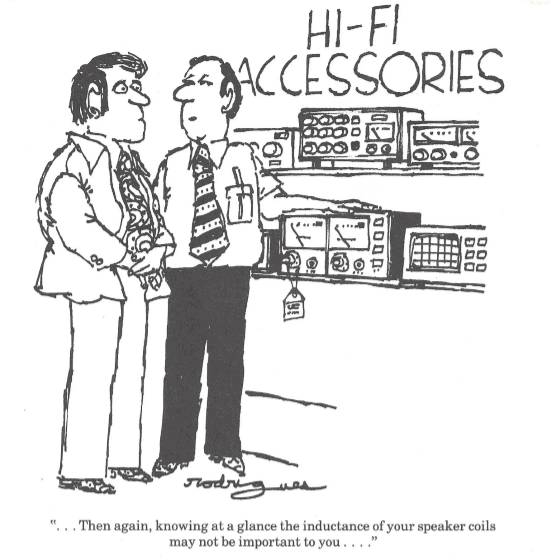
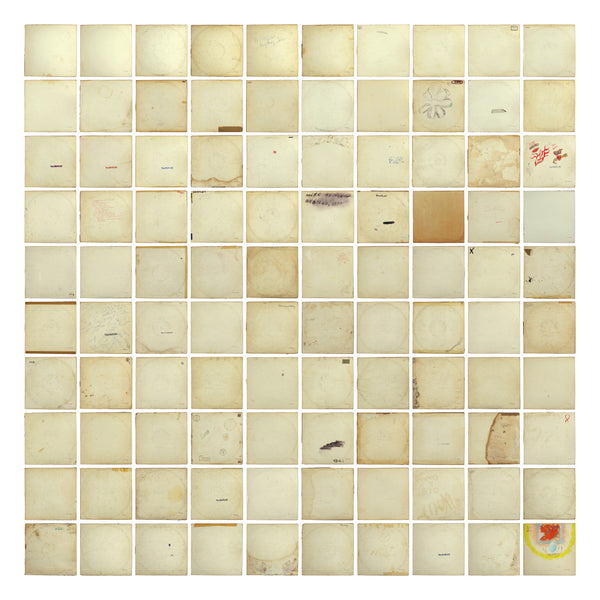
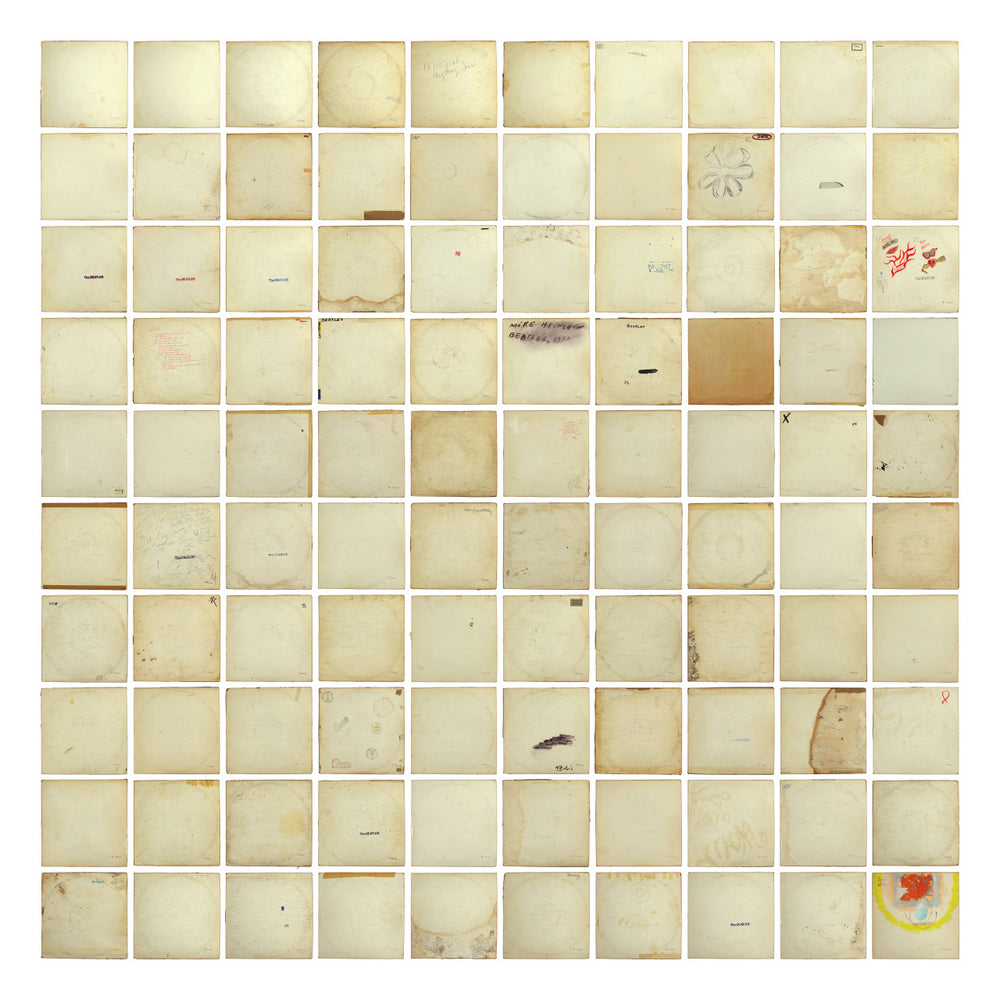
So You Think You Love The White Album?
Probably not as much as Rutherford Chang.
This is how I first heard about a collection of the Beatles’ White Album:
“Hey Jay Jay, there is a store somewhere that sells just The White Album.”
Hmmm, I thought, this is yet another level of Beatle Crazy that I needed to know about.
So, I did some research and was shocked to find out that the collector was (a) not really a Beatles fan and (b) his collection had nothing to do with the music!
First off, the collection of White Albums is not for sale. In fact, the man behind the whole affair, Rutherford Chang, doesn’t sell them…he buys them!
Then he travels with them as an art project and displays them in a self-described “store” at Beatles conventions. Hence the confusion.
I couldn’t wait to interview him. With the 50th anniversary of one of the Beatles’ greatest albums, I felt that now was the time!
Below is an excerpt from Wikipedia, which will give you a quick background of the history of The White Album cover artwork and its designer.
“Richard Hamilton, a notable pop artist who had organized a Marcel Duchamp retrospective at the Tate Gallery the previous year (1967), was responsible for the album’s original sleeve design. It is the only sleeve of a Beatles studio album not to show the members of the band on the front. His design was in stark contrast to Peter Blake’s vivid cover art for Sgt. Pepper, and consisted of a plain white sleeve with the band’s name discreetly embossed slightly below the middle of the album’s right side. The cover also featured a unique stamped serial number, ‘to create,’ in Hamilton’s words, ‘the ironic situation of a numbered edition of something like five million copies.’”
Hamilton has been quoted as saying, “Paul McCartney requested the design be as stark a contrast to Sgt Pepper’s day-glo explosion as possible.”
As a reader of all things Beatles related, I have heard/read rumors to the effect that John Lennon was so angry over Paul’s hijacking of the entire Sgt. Pepper/Magical Mystery Tour projects that he refused to pose for any pictures for the new cover (The Beatles’ double album, titled simply The Beatles), hence the decision to leave the album blank.
This was the first time that the Beatles were not presented in a group shot. The only pictures (both the black & white photos on the inside of the gatefold jacket and the separate color shots inside, suitable for removal to be taped up on your wall – I did!) are solo shots. That really says so much, as the album really has been referred to by none other than Beatles engineer, Geoff Emerick, as essentially 4 solo albums under one roof.
John Lennon received copy number 0000001. According to Paul, John yelled the loudest. [Confusingly, Ringo’s copy was auctioned in 2015 for $790,000, and was said to have serial number 0000001. Huh. —-Ed.]
Knowing this background, it is easier to understand and see what Rutherford Chang saw when he gazed upon the blank cover for the first time.
What Rutherford saw was art. A statement that reflected the times and over time that image, by how the albums were either written on by the owners or just the way they were stored in their respective record collections, began to tell him stories.
To begin with, the collection is solely based on the original run of albums that were sequentially numbered and manufactured in 1968/1969.
The albums had to be from the original run, 50 years ago, because it is time that tells the story (meaning how the white cover has aged over the years). This aspect is the art in the eyes of Mr. Chang. One look at his collection and it starts to become obvious. Maybe as a one off, it isn’t that apparent, but in an exhibition, (as in a wall of the covers) one starts to “see” what Rutherford “saw” many years ago.
Mr. Chang is a professional artist, so it is not surprising that, through the simplicity and minimalism of the cover, he saw what the creator Richard Hamilton saw. Rutherford just took it one…step…farther!
It is important to note that numbered White Albums in the original run were not just manufactured in the US. They were also manufactured in the UK, Germany, and Japan. These albums are also a part of this collection. Furthermore, The White Albums sold in America were the first Beatles’ release for sale only in stereo. There were no mono versions of the album manufactured in the US. The UK, however, did release both versions. The sonic differences between the two mixes are stark, but that is an article for another time!
And now, my interview with Mr. Rutherford:
Jay Jay French: How old are you?
Rutherford Chang: I’m 38. I was not around in the beginning…(laughs!) I am not a Beatles fan in the traditional sense.
JJF: When did you start collecting The White Album?
RC: I bought my first [White Album] in a garage sale, sort of randomly, as a teenager in the 90s [for a dollar]. I didn’t listen to the album that much. 12 years ago, I bought my second one (on ebay) and I became interested in collecting those albums. I began to see these albums as objects…they all went out to houses where they collected so much dirt, mold, graffiti, and artifacts that reflect this whole phenomenon of the Beatles and everything over the last 50 years.
Once I bought the second copy, I wanted to see how the unique copies became unique…so I kept going.
JJF: How so?
RC: This massive edition of these totally unique objects went out into the world for 50 years and is totally unique. They have different kinds of ring wear [that is the markings of the actual vinyl album that breaks through the bare cover over time and, in most cases, leaves a brown ring] mold, names written on them, (inc. art drawn on the cover by the buyer…ed) and they tell the story of the last 50 years. They are artifacts of the phenomenon of the Beatles. The way [the covers] have have been worn and torn says a lot.
JJF: You have no interest in buying a White Album that has no serial number, correct?
RC: Correct.
JJF: How many copies of The White Album do you have?
RC: Almost 2,100.
JJF: Do you make notes (serial number, date purchased, country of origin, etc.) on every single one of them?
RC: Yes
JJF: Do you ever sell the ones from your collection?
RC: I only buy White Albums. I don’t sell them.
JJF: Is it expensive to carry around the exhibit, and in how many countries has the exhibit been shown?
RC: The size of the collection obviously makes shipping not a small task, though it has managed to travel to several exhibitions around the world. I have shown it in 4 countries.
JJF: Do you listen, even for just a minute, to every copy you buy?
RC: I have not listened to every copy.
JJF: Are you still collecting White Albums?
RC: I still consider the project a work-in-progress and have not offered it [the collection] for sale.
Also, I would ask [people who look at the exhibit] if they would like to sell me a copy of The White Album. There are obviously a lot more copies out there.
JJF: What is the most you have paid for a copy?
RC: I’ve never paid more than $20.
JJF: What’s the lowest numbered copy in the collection?
RC: No 0002348.
JJF: When was the last time you bought a copy?
RC: August 26th, 2018.
JJF: Do you own a CD version of The White Album?
RC: No. I do not own a CD version. [laughs]
If you are interested in selling your numbered White Album to Mr. Chang, you can contact him here. You can also check him out on Instagram @webuywhitealbums.
[Since Jay Jay interviewed Rutherford Chang, the collection has added a few more albums. As of 8/8/19, the count shown here was 2,347. And no, I don’t pretend to understand this. —-Ed.]


The Long Goodbye
Over the last few years of writing this column, I’ve had to write “RIP” in titles several times as friends and colleagues have passed away. Being a typical male, I’ve reacted the same way with each new loss.
I got angry. I mean, really, truly, deeply pissed.
Maybe things are different with more recent generations. I’ve certainly tried to raise my children to be more accepting of sadness and mourning, but for most post-big-war upper-Midwestern males like me, the way we were trained to deal with such feelings was, as Garry Trudeau once wrote in Watergate-era Doonesbury, “deny, deny, deny!”
And at least for me, the default setting for denial is anger.
I’ve spent a good part of the day today being deeply angry. Which really means I was deeply sad and upset, but somehow owning that is harder to accept than being irrationally angry.
Sound familiar?
Anyway, this time there’s not an actual, physical death involved—just a metaphorical one. But that doesn’t make it any easier to deal with. In this case, a colleague in audio whom I’ve known for years, worked with in a variety of roles and in different situations, has simply said he can’t do it any more. He can’t take the acrimony and contentiousness and vituperative, anonymous venom that he’s experienced in this field. So a person whose talents and abilities I’ve marveled at, envied, tried to emulate—is dropping out of a field badly in need of far more mystical polymaths like him.
Poof. Gone.
Right now, I feel like the emotional equivalent of the laminated pastry of a croissant: the sadness and anger just keep folding over, layer after layer, until I can’t even begin to separate them and determine which is which.
I suspect this is not a healthy state of being.
It has always been a mystery to me how audio, supposedly based upon an appreciation of the wonder and joy of music, can unleash so much dogmatism and hostility. I can’t explain that. I suppose it’s possible that our community is just chock-full of poor souls who are emotionally repressed, just like me, unable to identify or express what they’re really feeling. And with them, just like me, the default setting is anger.
That’s pretty fucking pathetic.
In the weeks and months to come, as the absence of my friend becomes evident, the community will be just a little darker, a little less humane than before. While such losses come frequently and are frequently and quickly forgotten, they are still losses. And we are diminished by them.
Meanwhile: who shall replace him? Anyone?
Or will the response be like that of an aspiring audiophile who, upon reading exchanges on several online forums, asked me, “why is everyone so ANGRY?”
I had no answer then. And I have no answer now.
And that makes me angry.
The Mystery of The Making, Redux
I never think about how mysterious the process of contemporary record making is, or was, to the people who buy those records. Which, when you think about it, is really naïve — since I devour stories about the making of records I love like a good meal.
In the early days of recording with Bill Bottrell, his studio, Toad Hall, was new, and we experimented with the spaces. There are some outtakes from the early weeks of Triage (David Baerwald’s bleak and angry rant about America in the era of grunge was released in 1992, and seems startlingly prescient today–Ed.) that were recorded with the band in the large room, and the board, the control desk, in the little room. Other than the acoustic treatments, that’s the traditional set-up. By later in the album, the situation was reversed, and that’s pretty much the way it stayed. Even when I recorded Indian music in there, the larger room was still used as the control room.
Toad Hall was initially a bank, in the very early part of the 20th century. It was part of 3 reasonably identical spaces. Bill leased two of them and started what modifications there were. I first saw it, I suppose, early in the spring of 1991. It was still just coming together. My sometimes-roommate George Newburn was the acoustic consultant — he took me out there with an instinct that Bill and I would get along. I was surprised to see my good friend Robert Newman (who had been the Motels first drummer and whom I met when we played in Terry Reid’s band) was way up on a scaffold doing a faux-finish to a concrete beam, painting it to look like wood. I remember my visit there, that Madonna had just been in (and that George was mildly and humorously obsessed with the lipstick stains on her Styrofoam coffee cup). I vaguely recall that Bill and I talked about Neil Young, and were more-or-less in agreement that he was all that was left.
Meantime, Baerwald was calling constantly, talking politics, usually late at night, and I finally encouraged him to put down on paper what he was talking about. The next morning, my phone rang at 6 AM; he said, “I’ve got your left-wing rant written”, and he read me “The Got-No-Shotgun Hydrahead Octopus Blues”.
A couple months later two things happened: Baerwald was really leaning on me to produce his album, and George told me that he had found out that Bill was producing Michael Jackson. Well, I’m no dummy — I knew A&M Records weren’t going to trust me with $300,000, and I knew they WOULD trust Bill if he was producing Michael. So I called him, and very soon after, he, Baerwald and I were having drinks in Pasadena. (OK, they were drinking).
The next night we all got together with Brian MacLeod and Gregg Arreguin, and did our first recording. Then Bill was busy recording Michael, and Baerwald and I did a little development, When we reconvened in Toad Hall, we did a couple days with Kavi Alexander’s mics and drummer David Beebe, and then a few weeks with David Kemper on drums and pianist Nicky Hopkins for a day. And when we finally started the album in earnest about 4 months after our initial recording, the cast had settled: Bill’s tenant, Kevin Gilbert, MacLeod and Arreguin— and the studio was reversed, the big room was now the control room and the small room had become the drum room. There might have been a handful of studios set up that way, or Bill may have been the first. I visited Mark Howard at Teatro, Dan Lanois’ place in Oxnard 15 years ago, and by then they were set-up that way.
It was extremely dead sounding in the drum room, no reflections, and so the prevailing ambiance became dead drums, live everything else. The only real treatments in the live room consisted of acoustic fiberglass behind half-a-dozen long drapes, and a bass trap above a floor-to-almost-ceiling bookshelf in the back of the room. The console was a mid-70s Neve, and the tape machine a Studer A800.
But the real innovation came in the form of the collective musicians’ monitoring, the headphone system. For one thing, it was powerful, a 400-watt-per-side Bryston amp. But mainly, it didn’t allow for what came to be called a “More Me” control — it was 2 channels, a stereo send, and that was it. We all heard the same thing: if I wanted more me, everybody got more me. (That encouraged us to be pretty circumspect when asking for more of ourselves). I can’t adequately describe what this did for us — in all my years of playing, this was the first time that I had an experience of playing a record AS I was making the record.
Maybe I should explain myself: in working up that point, I had been used to using headphone systems that separated, rather than unified, the players. Everybody had a feed, usually one of 3 or 4 headphone sends — or sub-mixes — from the recording desk. That’s what everybody had, and it only got worse with years, finally enabling us to literally create our own mix. On a 2006 session with Jim Keltner and a half-dozen other players, Jim took off his phones and whispered to me, “What are you listening to?” Surreptitiously, we collaborated in hearing the same things.
This is probably among the many innovations that came with multi-track recording that led us down the garden path and away from really making MUSIC. My pal Terry Manning usually recorded with no headphones at all. It’s hard to imagine, as gloriously “primitive” as the REDD desks were, that the Beatles had multiple headphone signals.
In later years, I found myself so reliant on Bill’s system that even when we used a different studio, when he really didn’t want to engineer, I would sometimes needle him until we had a reasonable facsimile of his great set-up, if he hadn’t done it yet. He once referred to his headphone system as his real innovation.
Finally, there were usually enough open mics, a Neumann U47 with a very wide field of pickup, and a couple Neumann KM-54 or Schoeps small-diaphragm tube mics, to give us all a sense of being in the room — even through standard-issue AKG 240s.
As the record went on, things became more and more tense between David and I, culminating in us arguing in the “drum room”, away from prying mics, in which he said that I “took the lid off his anger” by encouraging him to write about what he was always talking about. I replied that I didn’t have to believe him to believe it was right for him to say what the album was saying.
Of course, after 25 years, it’s obvious that everything that he, and we, said on that album was utterly true.
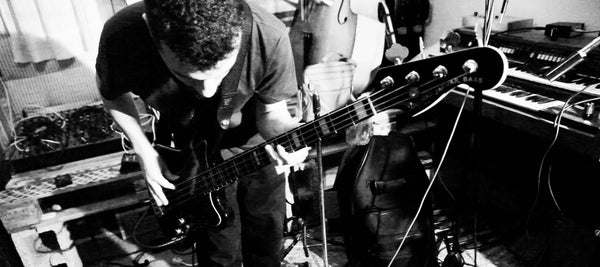
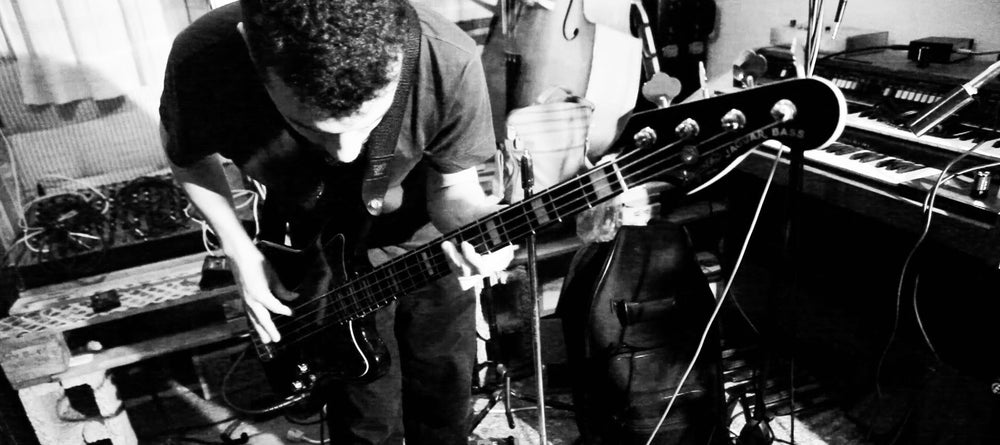
The Sound of Recorded Music
Different time periods in history are associated with particular architectural trends, building techniques and construction materials, different stages of technological development, as well as different styles and forms of musical composition.
Architectural trends had a significant influence on the spaces intended for the performance of music during different time periods and together with the techniques and materials employed, shaped the acoustics of these spaces. As such, each time period and geographic location had a particular acoustic signature, whether intentionally shaped or accidentally occurring as a result of the materials, methods, or ideas of the time.
When a musical composition is performed, the result is ultimately affected by the interpretation of the work by the performers, the sound produced by their instruments, and the interaction of that sound with the acoustics of the performance space. Performers adjust the nuances of their playing during a performance, based on what they hear, as a form of closed-loop auditory feedback control process. This is a near-instantaneous process which happens almost instinctively. Composers, on the other hand, adjust and refine their compositions over a long period of time, usually based on their auditory experience of performances. The logical extension of these relationships is that the different composition styles and forms of different time periods were influenced by the performance space acoustics of the time.
Up until the late 19th century, music could only be heard in the form of a live performance. The invention of sound recording changed everything. It introduced an entirely new possibility for experiencing music, by reproducing a recording of a performance, which happened in a different place, at a different time.
In sound recording, the medium and process can be thought of as an equally influential factor, as the performance space is to a live performance. Each recording medium, with its strengths, weaknesses, and limitations, affects the way in which the listener will perceive a certain composition and performance. It will therefore also affect the nuances of the performer, who will try to adjust their performance to the medium and its particularities. Over time, sound recording technology has influenced composition styles, arrangements, and performances.
The recording process actually starts with the composition. In a moment of inspiration (and/or years of refining), someone needs to compose the music. An outstanding composition can still be ruined in subsequent stages, but a mediocre composition cannot be made less mediocre by the rest of the process. It can only go downhill from there.
Once we have an outstanding composition, we need an outstanding arrangement, done by an arranger with experience of the record production process, to ensure the original intentions of the composer are properly represented in recorded form.
Then, of course, we need some excellent musicians who can perform the arranged composition with skill and virtuosity. In turn, they will need outstanding musical instruments to perform on, built by highly skilled craftsmen to sound stunningly good, based on centuries of tradition and pride in one’s craft, using the finest materials and tools available.
The actual performance must then take place in a space with acoustics suitable for the composition, but also for the recording process, adequately protected from external disturbances through soundproofing, while still maintaining the required acoustic signature within.
It is all of the aforementioned factors that will ultimately define the sound of the recording, if everything is done right. The aim of the engineers involved in the rest of the process is (or should be) to ensure that all of the collective excellence achieved thus far is properly represented and preserved up until the final product. If any of this excellence is missing, no amount of “engineering” or technical gadgetry could ever truly make up for it. Recording technology allows us to capture what is there, if we are skilled enough at using it to its full potential, but will not make the source sound better than it is, nor will it improve the composition, arrangement, or performance. Under certain circumstances, it can be used to mask some flaws or edit out mistakes, but there will always be serious side-effects. In other words, sound recording technology is not a substitute for skill, effort, quality, and intelligence. But it is a tool, that, when used in combination with skill, effort, quality, and intelligence, may allow us to preserve all this in recorded form.
This is done by means of microphones, strategically placed in the performance space of the recording facility. These convert the sound into electrical signals. The accuracy of this conversion depends on the quality of the microphones and their careful positioning in the space. The electrical signal produced by a microphone is rather weak, so a microphone preamplifier is used to amplify it, as accurately as the overall design and build quality of the preamplifier will allow.
Technically, all we need for an outstanding stereophonic recording is two microphones, one for the left and one for the right channel, two microphone preamplifiers, and the stereophonic recording device. A recording setup can range from being as simple as that to as complicated as hundreds of microphones, microphone preamplifiers, signal processing units, huge multi-channel mixing consoles, multitrack recording devices, effect units, artificial reverberation, multiple stages of re-recording, editing, adjusting, and so on. But less is usually more in this field. Even the finest audio equipment will introduce some signal deterioration, which may be insignificant on a high quality specimen. However, these “insignificant” deteriorations are accumulative and quickly become significant when a large number of devices are being used.
In practice, we also need a source of power for our equipment. This point is frequently overlooked, but electronic amplification actually works by modulating the power supply DC in proportion to the audio signal. The power supply is therefore of major importance to the overall accuracy of all audio electronics, but it also needs a clean and stable source of electricity, usually in the form of AC, which it would then convert to DC. Especially in these murky times of distributed generation and tons of cheap digital gadgets, electricity supplied through the grid contains all kinds of muck you certainly wouldn’t want anywhere near your audio equipment. The more serious professional audio facilities go to great lengths to ensure their equipment is powered from a clean supply. At Magnetic Fidelity, an analog recording and mastering studio I designed in 2014, I installed an elaborate microgeneration system, isolated from the grid, to power all the audio equipment. It runs on a massive battery bank, offering several hours of autonomy in case of electrical faults upstream, to ensure critical sessions will not be interrupted.
The analog audio electronics get a dedicated supply. The tape machine, turntable, and disk recording lathe motors, with their control electronics, get their own supply, isolated from the audio electronics. The lights, air conditioning, ventilation, fridge, and office equipment are powered by electrically isolated lines, going so far as to make sure that “dirty” power lines are not even physically located near the mastering room. Multiple stages of EMI/RFI filtering are in place and the grounding was given special attention to prevent ground loops. The “audio power” is distributed in a balanced fashion, where instead of “line” and “neutral”, there are “positive” and “negative” conductors, carrying identical voltage but in opposite polarity, running as twisted pairs.
In domestic listening rooms, the situation is much easier to cope with, as the power requirements are usually more modest, there are fewer pieces of audio equipment, shorter distances (all equipment is usually located in one room) and plenty of suitably sized power conditioners/filters/resynthesizers available to choose from.
Last but not least, the recording device itself also introduces side-effects, be it mechanical (disk recording lathe), magnetic (tape machine), or digital (Analog to Digital Converter). There are a lot of claims and outright lies regarding the “accuracy” of different sound recording technologies, but this is a topic for an entire book.
Having extensively used a large number of the world’s finest professional recording devices and doing A/B comparisons between the source signal and the recorded/reproduced signal, on exceptionally accurate full-range monitors, I can confidently state that there is no such thing as a truly transparent recording technology or device.
They all affect the signal, audibly and measurably. The better sounding ones affect it in ways which are less perceptible to our auditory system.
As such, I prefer to only use one recording device and avoid re-recording or mixdowns. But, this can only be achieved if the (excellent) musicians can (excellently) perform the (excellently arranged) composition, all together, like they used to do in the good old days. This makes any deficiencies in the recording equipment more blatantly obvious, so excellent equipment must be used, controlled by an engineer who absolutely must “play along” with the musicians and get everything right, on the spot, to succeed in really capturing the magic of the moment.
The development of sound recording technology past the 1930s was not always in the interest of more accurately preserving the magic of a performance.
For instance, it was customary to use two copies (on disk) of a recorded political speech on two turntables, with a mixer (pretty much what the DJ culture rediscovered much later) in between. One record was playing while the other was “cued” (stopped with the needle still on it at a particular spot), so the operator could skip a few words or sentences by switching in the cued record at the right moment and switching out the first one, thereby changing the message conveyed, to serve political propaganda requirements.
During the second world war, Germany invented plastic tape with a magnetic coating and combined it with AC bias recording, creating a high fidelity sound recording system which allowed far more elaborate editing. The tape could be cut with a razor blade and another piece of tape could be spliced in, anywhere needed, perfecting the art of political propaganda by making it possible to piece together a speech, word by word, using the recorded voice of any politician.
Obviously, elaborate editing possibilities were not exactly needed to fix an outstanding performance. Likewise, multitrack recording was not invented to enable a well coordinated group of musicians to perform each instrument individually, artificial reverberation was not invented to “spice up” the sound of a hall with great natural reverberant acoustics, and autotune was not invented to electronically tune the voice of Montserrat Caballé! It is well-tuned enough as it is, thank you!
As the dividing lines between composer, arranger, performer and engineer are becoming increasingly blurred, as traditional instruments are being replaced by synthesizers, software, and even recording/reproducing devices (not a new development, have a listen to Joe Meek and the Blue Men– I Hear a New World) and as our modern technology allows anyone to edit, tune, reverberate, loop, overdub, and layer sounds for a nominal investment, it is easy to forget that the basic principles and rules outlined earlier, still apply, regardless of style of music, choice of instruments, and type of recording technology used.
The sound of a recording is still defined by the composition, arrangement, performance, instruments, and acoustics of the space, which the recording equipment and engineer can either succeed in adequately capturing, or not.
This applies equally to all styles of music and anything one may decide to use as an instrument.
Here are two beautiful examples of two rock bands, performing all together, recorded on a stereophonic 1/4″ tape recorder, using a very minimal setup:
Lunar MGC – “Planemo”
Naxatras – “Machine”
Amidst promises of making space colonization viable within the next five years, I personally feel there is a lot of untapped potential right here on our modest planet; musical treasures yet to be discovered and preserved, if only we could remain a bit more “down-to-earth” about the whole thing.
[Header image of the Naxatras bass-player was shot during a recording session at Magnetic Fidelity. Photo by Elina Verykiou.–-Ed.]
Five New Releases, No Losers
Bleached – Don’t You Think You’ve Had Enough? Bleached is an L.A. band of sisters Jennifer and Jessie Clavin; they’ve been active on the punk/pop scene for almost a decade now, and are known throughout the west coast for their over-the-top and raucous live shows. The lifestyle was taking a toll on them, so they took some time off, cleaned up their personal and professional lives, and are back with a new record. Don’t You Think You’ve Had Enough? was the question they were constantly asking each other with regards to their seemingly out-of-control lifestyle, and the new album presents a newly-sober approach to their musical vision. While perhaps not as rough-hewn or raw as their previous work, the album’s producer Shane Stoneback (Vampire Weekend, Sleigh Bells) has helped Bleached craft a new sound that’s still true to their roots, but filled with plenty of new-waved hooks and fuzz-toned guitars. There’s not a bad song on the album, and it’s grounded with a propulsive, power-pop beat throughout that keeps you hanging on for the next tune. While GoGo’s/Bangles comparisons will no doubt proliferate, Bleached has a harder-edged sound that will easily distinguish them from poppier contemporaries. Perhaps the production is a bit slick, but nonetheless, it’s a well-crafted album that demands repeat listenings, and should help increase their exposure to a much wider audience. Highlights: “Heartbeat Away”, “Hard to Kill”, “Somebody Dial 911”. Highly recommended. Dead Oceans Records, CD/LP/Cassette (download/streaming from Bandcamp, Amazon, Tidal, Qobuz, Spotify, iTunes) Neil Young – Tonight’s the Night—Live at the Roxy, 1973 The Neil Young Archives project continues their series of distinctive live releases with this 1973 date at the inaugural concert for the Roxy, which has gone on to become one of L.A.’s legendary nightclubs. The studio album for Tonight’s the Night was just barely in the can—recorded just a month earlier—but the record company was unhappy with the very raw and stark wake it presented in commemoration of the overdose deaths of Crazy Horse guitarist Danny Whitten and longtime roadie Bruce Berry. So the raucous studio release was delayed for two years, and then most likely came as something resembling a sledgehammer to most Neil Young fans, who were probably expecting more of the tuneful folk and rock found on its predecessor (at least on the release timeline), 1974’s On The Beach. While the studio version of these songs was a deeply dark and somewhat disturbing listen—at least, on first hearing—but the performances presented here are anything but that! The atmosphere is almost festive, more of a celebration of the lives of the recently departed as opposed to a wake. And, of course, Neil Young’s traditional banter between songs is presented for posterity, and Neil and the band knew the songs well by the time of this performance. This is a very entertaining listen! The two-LP set reviewed here didn’t indicate if the pressings were 180 gram, and they seem somewhat lighter (perhaps 140 gram?) to me, and they were perfectly flat. And perfectly silent, with nary a click or pop during playback; no indication of the manufacturer, though the wax is inscribed with “manufactured in the EU”. As quiet as the pressings are, I’d venture to guess that they come from Pallas? Anyway, the sound quality and performance are exemplary, and while side four of the set is inscribed with a really cool laser etching, I’m certain most fans would probably have preferred a few more songs from the archive instead. Regardless, very highly recommended! Reprise Records, LP (download/streaming from Amazon, Tidal, Qobuz, Spotify, iTunes) Thom Yorke – Anima Hard to believe that it’s been thirteen years since 2006’s The Eraser, the first solo release for Radiohead’s Thom Yorke, but the icy electronica of Anima finds him treading some very familiar ground. Radiohead fans will find this music not at all dissimilar to their post-OK Computer output, where we’ve gotten fewer “fully formed” songs, per se, but still very cerebral listening. If stark electronica is your particular poison, well, this is a very darkly brewed cup! Be careful to mind the volume level during playback—the subterranean bass on this album will plumb the very depths of your system’s capabilities. If you have Netflix, I’d strongly suggest watching Paul Thomas Anderson’s Anima short that’s currently available there. It’s only about fifteen minutes, and sequences three of the albums songs, “Not the News”, “Traffic”, and “Dawn Chorus” into a single musical suite. It’s a very entertaining and visually striking watch, and for me presented Thom Yorke in a much more humanistic light than I might have previously given him credit for. And perhaps allowed me to view this album from a very different vantage point. Highly recommended. XL Recordings, CD/LP/Limited edition colored vinyl (download/streaming from Bandcamp, Amazon, Tidal, Qobuz, Spotify, iTunes) Paul Bley/Gary Peacock/Paul Motian – When Will the Blues Leave This album documents a superb live recording of this outstanding trio from a 1999 date in Lugano, Switzerland that has only now been released on the ECM label. Individually, each of these guys were giants, and had they recorded together a bit more prolifically, they’d easily be considered one of the greatest jazz trios of all time. I personally have a “thing” for the drumming style of Paul Motian, dating back to his days with Bill Evans, so I’m generally on board with anything he’s involved in. Paul Bley has always struck me as a bit too eclectic in his approach, but his playing here is sufficiently restrained to keep the proceedings very, uh, copacetic. This might actually be the most consistently enjoyable album of Paul Bley’s work I’ve ever heard. The recording quality here is on par with typical ECM live efforts. You get a really good idea of the recorded acoustic, and the players occupy well-defined positions on the soundstage, even if Paul Bley’s piano is perhaps somewhat too forward in the mix. Regardless, these three find a way to make these tunes really swing; the creativity of the interplay between them helps make this disc irresistible listening. Highlights: the sprawling “Mazatlan”, “Dialogue Amour”, and the title track “When Will the Blues Leave”. Highly recommended. ECM Records, CD (download/streaming from Amazon, Tidal, Qobuz, Spotify, iTunes) Nicole Yun – Paper Suit After a decade with the dream pop/shoegaze band Eternal Summers, guitarist and singer/songwriter Nicole Yun was more than ready to explore alternatives in the indie/pop universe. She left her home in Virginia and traveled to New York and Philadelphia, where she reached out to just about everyone in the industry who would listen, and not surprisingly, they were all stoked to assist. The result is Paper Suit, her debut solo album, which is a stylishly crafted homage to the dreamy guitar pop and Brit pop she grew up with in the nineties. Bands like the Sundays, Lemonheads, Jeff Buckley, and Juliana Hatfield. Sure, imitation is the greatest form of flattery, but this is no mere imitation. She plays and sings these songs as though she was there with Harriet Wheeler and Evan Dando. And her voice has an atmospheric, ethereal quality that delivers a vision that’s entirely her own. More an EP than a true album—it clocks in at just under 30 minutes—it’s nonetheless filled with clever and finely crafted pop tunes brimming with jangly hooks. Production chores were handled by Rob Garcia (Telepathic/Bleeding Rainbow) and Julian Fader (Ava Luna). This record could easily be the soundtrack to the summer of 2019, or maybe that of the coolest indie movie you ever saw. Highlights: “Supernatural Babe”, “And After All”, “Two Eyes”, “Destroy Me”. The intro and harmony bridge to “Two Eyes” is absolute ear candy. Waste no time in checking this one out—it comes highly recommended. Kanine Records, Limited Edition LP/Cassette (download/streaming from Bandcamp, Amazon, Tidal, Qobuz, Spotify)




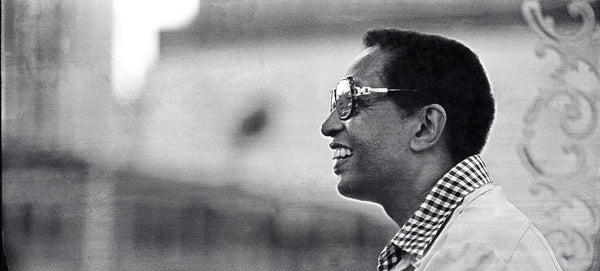
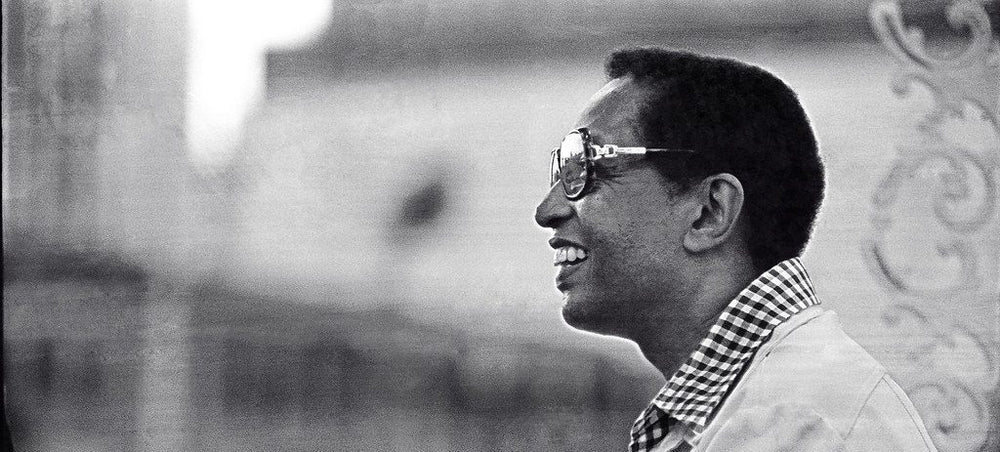
Billy Taylor: Eight Great Tracks
-
Pianist and composer Billy Taylor (1921-2010) grew up in Washington, DC, where he took classical piano lessons with a man named Henry Grant. Grant’s other claim to fame in jazz history is being Duke Ellington’s teacher – so you know the level we’re dealing with here! Despite that impressive start, Taylor chose a sociology major at Virginia State College until somebody pointed out what an excellent pianist he was.
He moved to New York in 1943 and got his first regular jazz gig with the Ben Webster Quartet. Although he mastered the standards with a delicate swing style, he loved the burgeoning be-bop scene. Soon he would become as important for composing as he was for playing.
By the 1950s he started to establish himself as an important jazz educator; NBC hired him as music director of The Subject Was Jazz, the first TV show on that topic. Later in his career, he won an Emmy as a music correspondent for CBS News Sunday Morning. His accolades and respected positions make a mighty list, including the post of artistic director for jazz at the Kennedy Center.
Over the years, Taylor became an ardent activist for the well-being of aging jazz and blues musicians, a segment of the population without much of a safety net. But probably most important to him overall was his role as teacher. He referred to himself as an “urban griot” (even giving that name to his penultimate album in 2000), a keeper and disseminator of jazz knowledge.
Please enjoy these eight great tracks by Billy Taylor.
“Give Me the Simple Life”

Prestige
1953
Taylor’s favorite way to perform was with bass and drums, a configuration he always called the Billy Taylor Trio, no matter who joined him. Here’s one of the early versions, with Earl May on bass and Charlie Smith on drums. In 1953 this was released as two albums (Volumes 1 and 2), but all twenty tracks were combined for the 1995 CD re-release.
- “It’s a Grand Night for Swinging”

Urania
1956
-
“Get Me to the Church on Time”

ABC-Paramount
1957
Just because Taylor was becoming an important jazz composer didn’t mean he walked away from the standards. But when he played well-known repertoire, like the songs from the Lerner and Loewe musical My Fair Lady, he gave them a distinctive touch.
It’s interesting that, among that show’s sweet melodies like “Wouldn’t It Be Loverly” and “On the Street Where You Live,” Taylor has included the comic, up-tempo number “Get Me to the Church on Time.”
The trombone solo is by Jimmy Cleveland, and Ernie Royal is again on trumpet. The arrangements are by a young man poised to become an American music icon: Quincy Jones.
- “Warm Blue Stream”

Riverside
1960
“Warm Blue Stream” is by one-hit wonders Sara Cassey and Dotty Wayne, who saw their song recorded by many jazz dignitaries, including Stan Kenton, Nat Adderley, and even the pop-leaning big band of Harry James.
As you can tell by the song-like phrasing, this tune originally had lyrics comparing a wistful love affair to the ripples of a stream. Taylor’s ethereal playing reflects that. Ray Mosca’s brushwork on the drums completes the worldbuilding.
- “I Wish I Knew How It Would Feel to Be Free”

I Wish I Knew How It Would Feel to Be Free
Tower
1968
Taylor co-wrote the spiritual-like title song of this album, and it became his best-known and most-recorded tune. Taylor himself recorded it many times; this is his second version on vinyl, the one picked up by the BBC as the theme song for its Film Show review program.
This live performance with Ben Tucker on bass and Grady Tate on drums finds Taylor weaving through a number of different styles, from a chord-based laying out of the simple melody (inspired by typical church organ playing), to a decorated swinging toe-tapper, and then to a passage of complex harmonic shifts.
- “A Tune for Howard to Improvise Upon”

Taylor-Made
1988
In 1988, Taylor started his own record label, Taylor-Made. It lasted only two years, and he was featured on all seven of its releases.
This solo album is culled from live performances and, true to its name, has Taylor playing without the trio. For anyone who doubts that he could have mastered Liszt and Schumann piano works if wanted to, there are plenty of tracks here to make you a believer. My heart goes out to the “Howard” in the title, who is expected to improvise to this devastatingly difficult tune. (It starts at 4:05.)
- “Line for Lyons”

Dr. T (with Gerry Mulligan)
GRT
1993
One of Taylor’s many fine collaborations was this album with bass saxophone guru Gerry Mulligan, who appears on three live tracks. Mulligan’s early-’80s composition “Line for Lyons” is an angular bop tune, presented in the intriguingly hoarse yet singing tones of Mulligan’s bari-sax. But when Taylor comes in with his first solo, he smooths things out with a swing sensibility.
- “Wrap Your Troubles in Dreams”
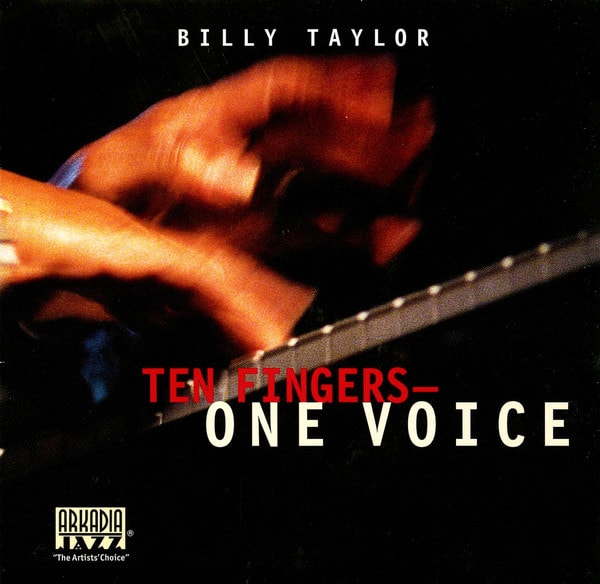
Arkadia
1998
Taylor was 77 when he recorded this solo album, one of the last few he made.
This standard tune dates back to 1931. Taylor opens with a slow version. His touch isn’t quite as light and silky as it was 45 years before, but the melody still sings and swings. But then he picks up the pace and starts to decorate the tune — It’s odd not to hear bass and drums come in at this moment, but the quiet sibilance of Taylor’s own unmiked scatting is percussion enough — with glittery passages and popping chords. And of course, there’s that harmonic imagination and the use of counterpoint, as if he’s a whole band unto himself.
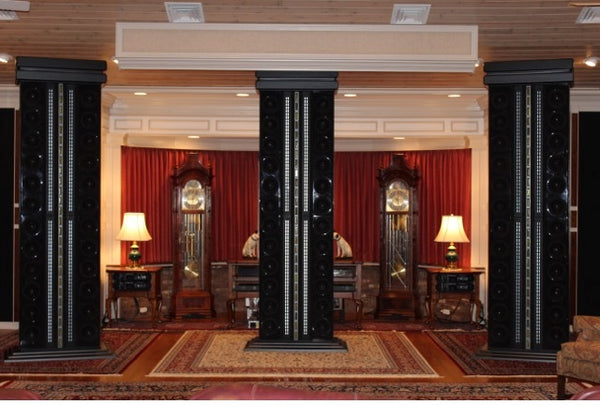
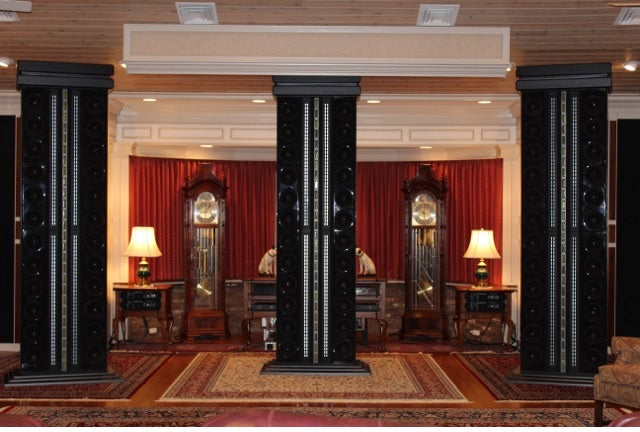
A Turntable of my Own, Part 2






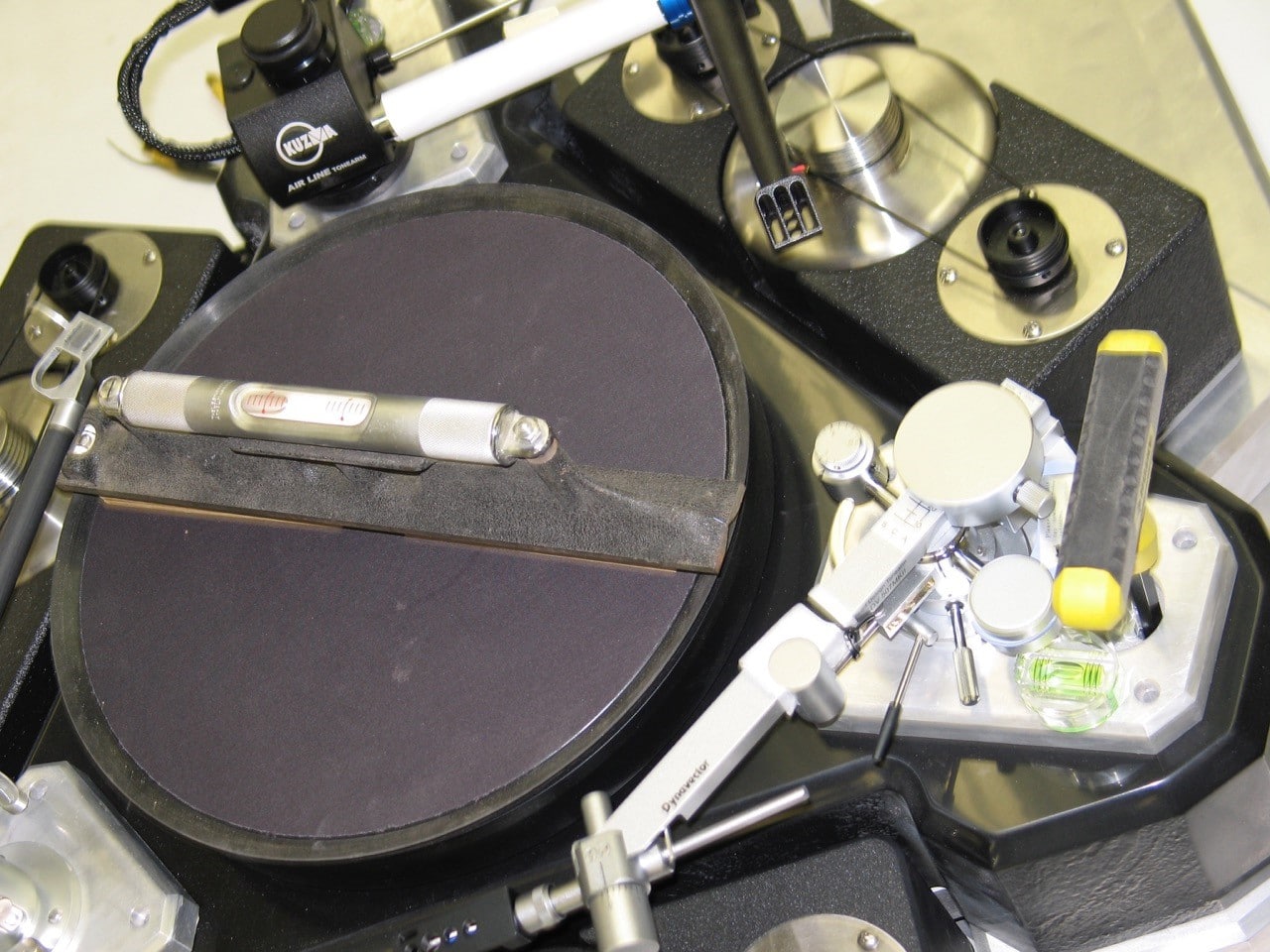 Here we see the platter with a 12” Starret machinist level atop. On the right side, you will notice a T-handle allen wrench going through the plinth down to the brass adjustment point that is used to level the table. The Starret machinist level has graduations equal to 1/1000th of an inch per foot.
Here we see the platter with a 12” Starret machinist level atop. On the right side, you will notice a T-handle allen wrench going through the plinth down to the brass adjustment point that is used to level the table. The Starret machinist level has graduations equal to 1/1000th of an inch per foot.  Pictured are the aluminum pieces I designed to hold the inverted bearing for the Sota vacuum platter I will be using.
Pictured are the aluminum pieces I designed to hold the inverted bearing for the Sota vacuum platter I will be using.  Here we see the anodized bearing cup supports installed on the fiberglass plinth.
Here we see the anodized bearing cup supports installed on the fiberglass plinth. 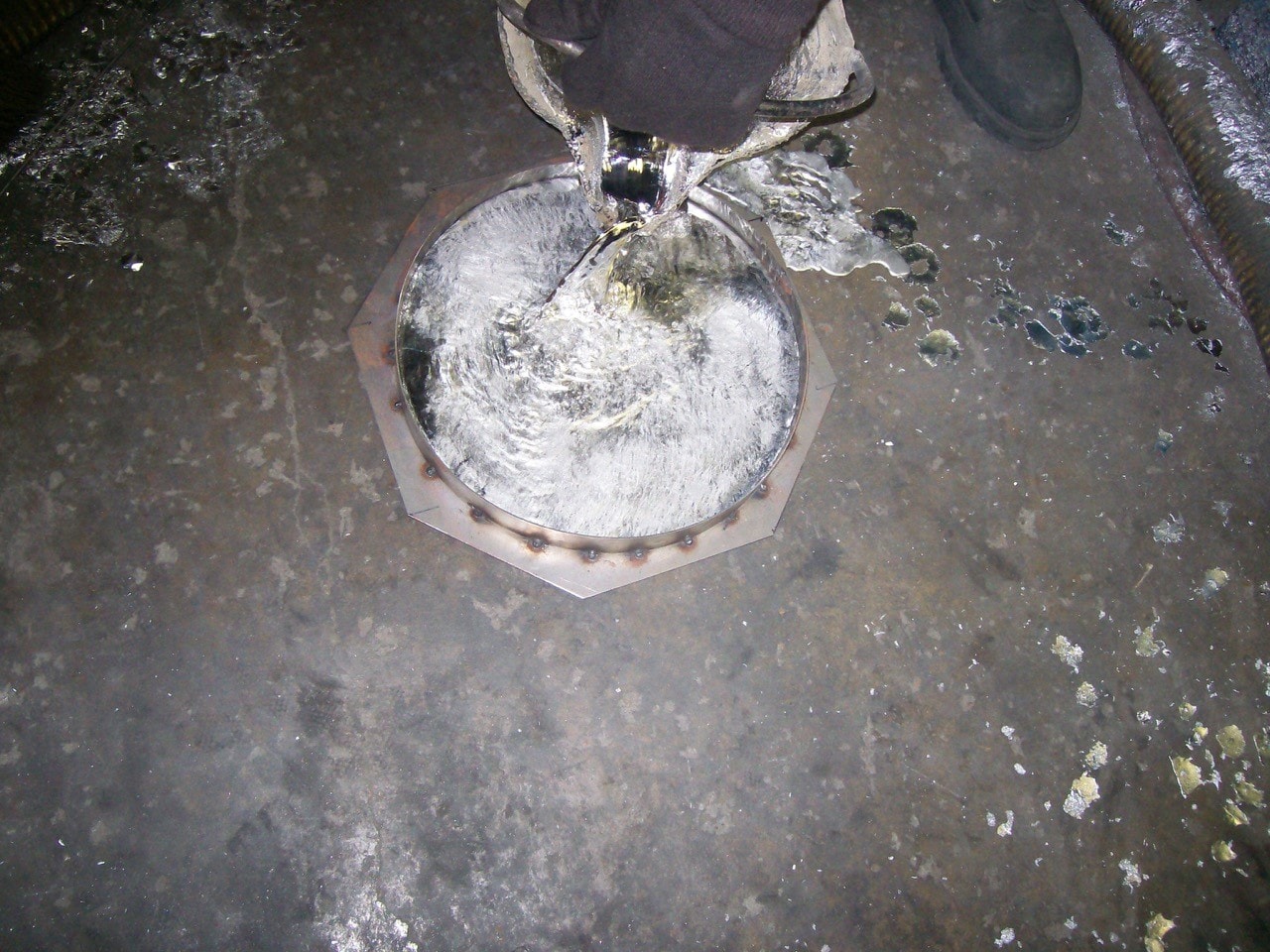 A steel mold was fabricated for casting the 1” thick lead disc that will be bonded to the top of a standard Sota vacuum platter. This steel mold was sent to a supplier in Ohio that casts lead parts for the medical industry. Two of these platters were poured, rather than just one, in case I thought some day I might make a second turntable. Yeah right.
A steel mold was fabricated for casting the 1” thick lead disc that will be bonded to the top of a standard Sota vacuum platter. This steel mold was sent to a supplier in Ohio that casts lead parts for the medical industry. Two of these platters were poured, rather than just one, in case I thought some day I might make a second turntable. Yeah right.
 Here we have a good friend of mine, an expert machinist, finishing out the lead discs.
Here we have a good friend of mine, an expert machinist, finishing out the lead discs.  A closeup view of the machining operation. After the two lead discs are machined, they were sent to Sota Industries so that they could bond this plate to the top of the Sota sub-platter. After that process was completed, the acrylic/rubber vacuum disc was then bonded to the top of the lead disc.
A closeup view of the machining operation. After the two lead discs are machined, they were sent to Sota Industries so that they could bond this plate to the top of the Sota sub-platter. After that process was completed, the acrylic/rubber vacuum disc was then bonded to the top of the lead disc. 
Depicted here is one of the two completed platters that came back from Sota. They bonded and finished the edges of the platter in the same manner they finished their standard Sota platters. This lead disc added approximately 85 pounds to the weight of the existing Sota vacuum platter. Before I decided to implement an extra lead disc, I conferred with Kirk and Donna at Sota regarding the weight capacity of the ball in their inverted bearing system. They told me that David Fletcher, who was instrumental in the design and weight capacity of their inverted bearing system, designed it for a weight capacity of 150 pounds. After the platter was installed, a dial indicator was used to measure the runout of the lead platter. It was immeasurable, as was the runout on the Sota platter to which it was bonded.
[We will continue with Part 3 in the next issue—Ed.]
Django, Act 5
On January 29, 1947, Django Reinhardt landed in New York. Because of poor communications, Django was a late add to the new tour and Ellington didn’t have the arrangements for guitar and the large band, so he decided to use a smaller backup group for the guitarist. This was complicated by Django showing up with no guitar. He was convinced the American guitar manufacturers would be so thrilled with his arrival that he would be showered with instruments. It didn’t happen. Reinhardt ended up borrowing money for a guitar and purchased a new Gibson L5. The decision to go electric was strictly to compete with horns in a concert setting, but what resulted was Django with a new instrument and new arrangements he couldn’t read.
The band had to rehearse the arrangements just before the first show in Cleveland. A personal account of an audience member talked of every guitar player in the region being at this show. And of course, Django killed. Band members like Johnny Hodges and drummer Sonny Greer were blown away by Reinhardt’s natural ability to hear a song once through and own it. And he figured out that L5. Probably helped that this is arguably the best jazz guitar ever made.
Django with the Duke enthralled American audiences. In Chicago, he was late for the first show with the audience beginning to believe he was a no show (Django’s reputation preceded him). But then the Duke announced the ‘incomparable’ Django Reinhardt and they were off. Fortunately for us, there was a recording engineer in the house with a wax lathe to bring us recordings from that show, like “Honeysuckle Rose”:
And “A Blues Riff”:
Next up was Carnegie Hall for two shows on November 24 and 25. The first show was packed; the advance publicity was strong for the venerable hall. Ellington played for a while and then brought out Django with the smaller backing band. And again, the audience reaction was thunderous.
However, the second night Django was not to be found. Finally, the Duke had to apologize to the audience and announce Django Reinhardt would not appear that evening. Then at 11PM a disheveled Django roared up to the hall in a cab, and without a guitar. He had found a French friend earlier in the day and lost track of the time. They had to dig up a banged up old guitar from a back room with old strings loose on the fretboard. The possible disaster was once again saved by Reinhardt’s huge talent. The audience went to their feet several times and the applause was deafening.
But critics, being what they are, particularly NY critics, were heavily polarized. Some missed the big band. Ellington couldn’t do the big band for lack of arrangements and he felt music was changing, with everyone going to smaller combos. Others were completely won over by the concert and by Django.
After the tour Reinhardt was booked for 4 weeks at the prestigious Cafe Society in uptown Manhattan. The band was great for the first week but Django became bored with the material, as he often did. By that time, he was also lonely and completely disillusioned with the wiles of America. Eventually he refused to play more than the four guest solo pieces required by union rules, naturally upsetting management.
Despite offers from Benny Goodman and Tommy Dorsey for a West Coast tour that would have catapulted Django into the arms of Dorothy Lamour, he found himself done with America. He missed his family; he missed Paris and especially the community of all his Romany cousins. He went back to France, but now with some modern jazz chops under his belt.
In 1947 he was reunited with Stephane Grappelli, Nin-Nin, and Jean Ferret, and in March recorded some sides that showed the influence Django had brought from America, including a bass solo fer crying out loud. Simply titled “Blues”.
And the bebop anthem “How High the Moon”. You’ll hear modern drum accents in Django’s rhythm playing.
Later he again recorded with the Nouvelle Quintette, including a bebop tune Django wrote and named after his beloved son. This is a double header with Grappelli helping on “Babik” (listen for homage to “Salt Peanuts” in there) and then “Belleville” with Rostaing on clarinet and Django on electric, which he now owned completely.
The years 1949 to 1950 Django lost heart in music and retired to paint, a passion he had picked up recently. Thankfully he was saved in 1951 when Hubert Fol dragged him back with a new ensemble that presented exciting new possibilities. Reinhardt was once again all in and having a ball. Delauney arranged some broadcasts at the Club Saint-Germain that brought back his popularity and energized his creativity.
In 1952 they recorded again and we have his bebop masterpiece “Nuits de Saint-Germaine-des-Pres”:
By 1953 Reinhardt had moved his beloved family to a sleepy fishing village on the Seine, Samois-sur-Seine. Django was happiest here, spending mornings in the cafe with his pals drinking coffee, playing billiards or cards or fishing in the afternoons.
He still composed and recorded, and in January he and Fol recorded the beautiful “Anouman” which Django wrote for Fol’s alto aka Duke/Hodges.
In May 1953, Norman Granz was organizing a group of shows called Jazz at the Philharmonic, with an eye to tour. The headliner was Lester Young with Roy Eldridge, Oscar Peterson, Ben Webster, and Benny Carter. Granz invited Django on the tour, which was going through Europe, America, and Japan. Imagine man. Django went crazy with renewed dreams of conquering the world and during rehearsals he recorded his revitalized and quintessential “Nuages”.
But Django had been complaining of severe headaches and problems with his hands. Everyone, including Naguine, begged him to go to a doctor. But he had the Gypsy distrust for all authorities, including doctors, and was not helped by memories from his burn incident 25 years previous. He refused to go.
On the morning of May 16, 1953, during a breakfast before a planned fishing trip, he collapsed. A doctor was finally summoned but it was too late. Django Reinhardt had suffered a cerebral hemorrhage and never regained consciousness.
The influence this wild man had on future guitarists is as varied as deep. Jeff Beck called him “the most astonishing guitar player ever.” Peter Frampton, Charlie Byrd, Wes Montgomery, and Joe Pass. Tony Iommi lost the tips of two fretting fingers early in an industrial accident and gave up the guitar. A friend showed him a Django recording and told him the story. Iommi fashioned homemade prosthetics and we got Black Sabbath. Julian Bream, Chet Atkins. Dicky Betts from the Allman Brothers wrote “Jessica” as a tribute. Jerry Garcia, Jimi Hendrix (think Band of Gypsies). Angelo Debarre, Tchavolo Schmitt, Babik Reinhardt (son), and David Reinhardt (grandson).
Today there are Django festivals all over the world and every summer guitarists gather to celebrate the wonderful Manouche Jazz we couldn’t have had without the incomparable Django Reinhardt.
I will leave you with my favorite recording from that Chicago date with the Duke. Dj by himself.
You have got to be kidding me.
For those of you brave hearts that have stuck with me, I have to credit most of my research to the definitive biography, by Michael Dregni, Django: The Life and Music of a Gypsy Legend. This is truly a wonderful bio from which I borrowed unabashedly. If you are a Djangologist this is a must read. Fully the last 15% of the book talks of the wonderful guitarists and recordings that followed Django’s demise and make for a whole new journey. Enjoy.
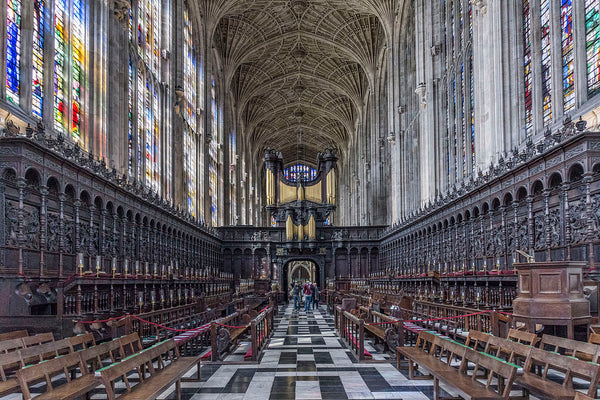
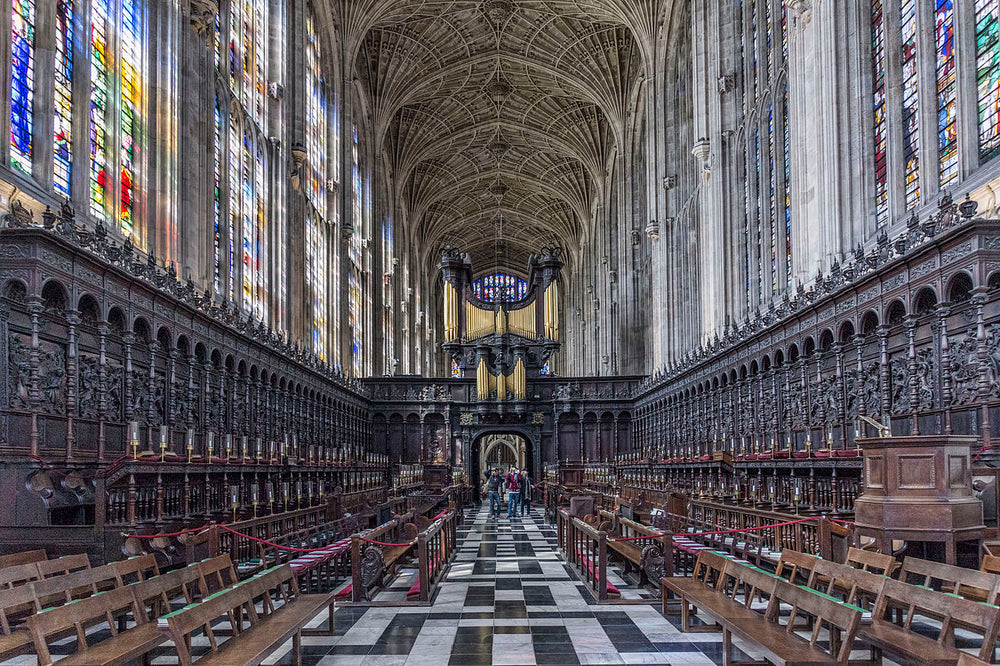
Hall Sounds
Late this May I fulfilled a longstanding wish—to attend Choral Evensong at King’s College Chapel, Cambridge. Director Stephen Cleobury retired at the end of June; this was one of the last times he presided over the Choir and the service. It was quite an evening. The Chapel itself, with its high vaulted ceiling, stained glass windows, and splendid Late Gothic architecture, provides an inspiring visual environment. If you also know something about its history and the Choir’s continuing significance, you’ll be properly awed before you ever take a seat.
Those who queue up early get to perch in the choir stalls. That way they hear more of the Choir and less of the room, which I’m told has a 12-second reverberation time. (From the stalls, it feels more like three or three-and-a-half; see comparisons here). As the choirmaster makes his way to the lectern, an inevitable hush falls.
Yet when the Choir begins to sing, one feels as if the chapel has been flooded with light. The intensity of the sound is physically shocking. If I hadn’t been seated already, I might have collapsed on the spot. (The Introit for 31 May was Byrd’s brief, exultant Psallite Domine, perfect for the moment.) Somehow the Choir has, over the centuries, learned to use the Chapel’s vast inner space as a kind of amplifier. They are not defeated by this room; instead they seem to regard it as their own Marshall Stack. As that day’s service continued with Byrd, Victoria, and Tye, I adjusted to the extraordinary music being made, but I was never less than astonished by its beauty and coherence.
Great works from the British cathedral tradition—Palestrina, Victoria, Byrd, and Tallis; Parry, Vaughan Williams, Britten, and beyond—form the core of this Choir’s repertoire. The Chapel thoughtfully provides well-worn books with English texts for the most frequently used service music. Nevertheless, selections are continually refreshed and varied, venturing well beyond the core; recordings issued on the King’s College label reflect this effort as well. Their newest SACD, issued in June, features music by Herbert Howells (1892–1983), including some first recordings.
Howells and the King’s College Choir enjoyed a long, fruitful association. Indeed, one of his earliest efforts, the Three Choral Anthems (1918–20), has remained in their repertoire for years. The second of these anthems, “A Spotless Rose,” will be familiar from its frequent appearances in the Choir’s annual Christmas Eve Service of Lessons and Carols.
Here the basics of Howells’ style are already apparent: long, sinewy melodic lines and richly impressionistic harmonies. Together they impart an inward, yet sensuous quality to whatever text is set. By 1944, when Howells created the Collegium Regale canticles for King’s, he was capable of creating a Magnificat that reflected his deepest concerns, including what biographer Paul Spicer awkwardly terms an “almost obsessive feeling for women.” (Translation: the composer was known for his roving eye.) Regarding the Song of Mary, Howells suggested that “the mighty should not be put down from their seat with a brute force which would deny the canticle’s feminine association.” Accordingly, he prefaced the parts in the Magnificat text about God the Father’s “strength with His arm,” etc. etc., with an exquisitely delicate opening:
Disc 1 is given over to the Collegium Regale Te Deum and Magnificat plus An English Mass, from 1955–56. Howells’ relationship with religious faith was complicated, to say the least. After the unexpected death of his son Michael—from polio, at the age of nine—his music more often voiced dark feelings about the nature of the universe. Consider the Kyrie of the Mass:
Disc 2 offers a contrasting turn: Howells’ Cello Concerto, with two of its three movements newly reconstructed from the composer’s short scores and sketches. Cellist Guy Johnston, a former King’s Chorister, is the soloist; Christopher Seaman, another King’s alumnus, conducts the Britten Sinfonia. Here’s a bit of the finale:
Cleobury rounds things out with three of Howells’ organ works. These show the influences of Tallis, Vaughan Williams, and others. Nevertheless, if you want to hear the Chapel organ in all its glory, get Cleobury’s 2017 recital, The King of Instruments: A Voice Reborn. It’s a thrilling demonstration, especially in multichannel sound.
Other Voices, Other Rooms: Years ago, just as SACD and DVD-Audio were being introduced, I served as general editor of recording reviews for Choral Journal. Many of the choral discs we received for review were offered in the new formats, especially SACD. I devoted most of one column to its advantages, technical and aesthetic; several of my reviewing colleagues also took up the cause. Choral labels (like King’s and Gloria Dei Cantores) and hi-res independents (like 2L and Sono Luminus) have continued to champion immersive vocal sound. Before its untimely demise, Harmonia Mundi USA also issued superb multichannel choral recordings.
Why did choral fans apparently take to multichannel in a (relatively) big way? For many of us, singing in the midst of other singers—being surrounded by vocal sound—was transformative. It never got old. Anyone who’s ever sung in a group (especially in scrambled or quartet formation) will recognize that special, shared energy. You hear everything. You’re part of it.
Two new recordings from Morten Lindberg’s 2L bring us fresh hi-res choral sound, and—like the King’s College releases—they reinforce the foundational importance of the room. Lindberg likes to work in big churches with high ceilings. Both of his new albums were recorded in Oslo’s Uranienborg Church, which offers that sort of space. Yet the music on Trachea (2L 154) could hardly be more different from that on Himmelborgen (2L 149).
Himmelborgen is a hymn collection with surprises. Some familiar congregational songs are given clean, straightforward treatments:
Other tunes receive elaborate arrangements that amount to re-composition. I’ll spare you the utterly avant-garde “Amazing Grace,” but do check out track 12: “Å, for djup i Jesu kjaerleik” (“O the deep, deep love of Jesus”), a 19th-century English hymn, which gets a new eight-part arrangement by Henrik Ødegaard (b. 1955) that “exploits the tune’s folk music qualities.” (Okay, see if you can hear the folky bits.)
There’s something for everyone in Himmelborgen. Yet it’s all sung in Norwegian and features hymns with special meaning for Norwegians. You may find Trachea and its emphasis on new music more rewarding. The Schola Cantorum of the University of Oslo is joined variously by four horns, a jazz saxophonist, and a Hardanger fiddler. Here’s an excerpt from Snilla Patea:
And the impressive title track:
By the time you read this, 2L’s physical package, consisting of a hybrid SACD and a Blu-ray Pure Audio disc (with height channels and more) will be available in addition to the downloads mentioned in Jason Victor Serinus’s review. Excellent SQ, of course.
More Howells: What if you’ve heard the Howells album from King’s and want to hear more of him? If you preferred the choral works to the complex, ruminative Cello Concerto, perhaps your next Howells should not be more choral music but instead—and I know this is counterintuitive—the short, accessible instrumental pieces on a recent Naxos album: String Quartet No. 3, “In Gloucestershire,” Lady Audrey’s Suite, and the A-minor Piano Quartet. It’s got lovely melodies but doesn’t ask you to wade through miles of contrapuntal underbrush. Here’s a taste of “In Gloucestershire.” (There’s more of everything on YouTube.)
If you’re not so taken with Howells’ service music but are quite fond of “major works,” try the dramatic Stabat Mater (Naxos again) recently recorded by David Hill, The Bach Choir, and the Bournemouth SO. Hill incorporates crucial tempo changes Howells made in 1965, casting this little-known work in a new light. The result is electrifying.
There’s no way that brief excerpts can give you a sense of the profound emotion in Howells’ Stabat Mater. I’ll just say the composer overcomes a lugubrious medieval text with bold strokes that hold your attention while never sacrificing the overwhelming grief at the center of the work. Soloists Benjamin Hulett and Alison Hill shine here, and also on the 1922 Sine Nomine that rounds out the album:
Steve Winwood & the Spencer Davis Group
It was 1963 in Birmingham, UK, when guitarist/songwriter Spencer Davis convinced Muff Winwood and his little brother Steve, only 14 years old, to join him in a band. With the brothers on bass and keyboards, they just needed a drummer; Pete York was the man for the job. They called themselves the Rhythm and Blues Quartette. But the name changed to the Spencer Davis Group in 1964, when they signed with Island Records.
Davis and his friends were part of the growing British obsession with American blues music, a musical love affair that shaped the playing of Eric Clapton, the Rolling Stones, and other artists of the so-called British Invasion. A great fan of bluesmen like Huddy Ledbetter and Big Bill Broonzy, Davis tried to pull that kind of sound from his guitar. At the same time, young Steve Winwood was already enough of a master on the Hammond C-3 organ that he accompanied folks like John Lee Hooker and Muddy Waters when they swung by Birmingham on tour.
Appropriately titled Their First LP, Spencer Davis Group’s debut came out in 1965. The 12 tracks included some originals by band members and some covers by Hooker, Joe Seneca, and even Ike Turner. Stax Records regular Rufus Thomas wrote the high-energy “Jump Back.” Maybe the most remarkable thing about this early recording is the confidence of these young musicians. They’ve made this music theirs, and they’ve clearly put in the work to be worthy of it.
On the other hand, this slow and heart-tugging Steve Winwood solo, his own composition, shows the band’s emotional side. Through the keening, warbling organ layered over a light-fingered piano line on “Here Right Now,” Winwood proves he doesn’t just admire the masters, but has absorbed some of their techniques. Brother Muff adds an expressive touch to the bassline.
The Second Album (1966) was not released in the U.S., although the single “Keep on Running” managed to break the U.S. top 100. Maybe SDG was ahead of its time, a little too soon for America to “get” the British blues thing. Winwood’s post-SDG projects brought him greater fame.
But America’s lack of response takes nothing away from the value of these albums. Here’s Curtis Mayfield’s “You Must Believe Me.” As usual, the arrangement is as tight as the vocal harmony.
The Winwood brothers stuck around for one more album, Autumn ’66 (1966). Then Steve joined the band Traffic, and Muff became an A&R rep for Island Records.
This left the band down one singer and without piano, organ, or bass. At first guitarist Phil Sawyer and keyboardist Eddie Hardin were brought in, and they quickly recorded a single, “Time Seller.” The B-side is “Don’t Want You No More,” which really lets Hardin shine on the organ. His solo around 1:42 has a jagged edge, an interesting and appealing contrast to the smoother Winwood style. At this point Davis started playing bass guitar to make up for Muff’s departure. He keeps a fine and funky beat. Sawyer is singing.
This lineup participated in making the soundtrack for a 1967 film called Here We Go Round the Mulberry Bush. (These and other rare tracks can be found on the 2016 retrospective on RPM Records, Taking Out Time: The Complete Recordings 1967-1969.) One especially nice tune from that film is “Every Little Thing,” with Sawyer providing a soulful solo at 1:29.
As of the album With Their New Face On (1968), SDG becomes a revolving door for personnel. But Sawyer wasn’t happy with the way the band had started leaning toward pop, so he bolted after recording most of this record.
The first appearance of his replacement, guitarist-singer Ray Fenwick, was on the 1967 pre-album single “Mr. Second Class,” which was later included on With Their New Face On. Its flip side, “Sanity Inspector,” has some elements that would have seemed fun to some ears and annoying to purists: electric keyboard, cute timbral additions like a triangle, and obvious trip-you-up metrical switches from duple to triple time and back (a very late-Beatles touch).
Fenwick wrote the majority of the songs on the album Funky (1969), which was only released in the US. It features Nigel Olsson is on drums for some tracks, replacing York, and Dee Murray is on bass. Legal issues prevented the record from coming out in the global market.
The track “Firefly (Funky)” finds Fenwick focusing on more jazz-fusion elements than blues or pop. The sound is so slick that it’s hard to believe this is the same band. In a way, of course, it’s not.
After the stressful legal experience of Funky, SDG officially split up; everybody went off to work on other projects. But a few years later, they were back at it to produce Gluggo (1973). Although Fenwick was still with them, this was more a rock album than a jazz/blues record. Bassist/vocalist Charlie McCracken, who’d previously worked with the band as a session musician, is brought in as a full member at this point.
Here’s a snarky rock song called “The Screw” by Hardin and Fenwick. McCracken’s presence is certainly felt in that bass-heavy mix.
Living in a Back Street (1974) was to be the last SDG album. It was produced by Deep Purple bassist Roger Glover, who gave it a pounding energy typical of his work. York’s frantically rolling drum part gives the title song something close to a Southern rock feel.
The Spencer Davis Group was quiet for a long time, but in 2006 they reunited to tour, with only Hardin and Davis himself still around from the old days, collaborating with session players. Hardin died in 2015, but Davis is still working. The most recent SDG tour was in 2017.
Although they haven’t made any new recordings since 1974, they have managed to get some of the rarer stuff out there officially, including a 2007 collection called Bootlegs and Unplugged. Always good to see a band reclaiming what’s rightfully theirs.


Budapest
I was sitting on a bidet in Budapest, thinking of Sam Tellig.
Sam had told me about the Gellert baths many years ago. It’s a massive building decorated in Art Nouveau style. The spa, originally built about 700 years ago, was built over thermal springs and has many pools at different temperatures including an outdoor wave pool and bubble bath.
Sam had come here a few years ago to wallow in the waters along with lots of other super-sized eastern Europeans. With his pasty complexion and his sallow appearance he must have fit right in. Although from an allegedly patrician background (he talks with a very pompous new England accent) he is mystically drawn to Eastern Europe. He speaks Russian. His wife Marina is Russian; his daughter Amy speaks many Slavic tongues. He also visited, along with groups of Stereophile readers, the Soviet Union in the old days. His humor is much darker than mine. Perhaps he’s a spy? But for which side?
For those who don’t know Sam Tellig, he was the most popular writer in Stereophile Magazine for many years. He wrote a column called “The Audio Cheapskate” [And later, “Sam’s Space” -Ed.] in which he often mused about characters in the Hi-Fi Field. He brought them to life in a way that I can only dream of doing. His columns were always funny and oft evoked a response from myself. Sam and I would banter (curse and denigrate each other) from month to month and many people thought of us as enemies. Quite the opposite was true. We were (still are) really good friends. I am sorry he has stopped writing, as I know he still has a lot to say. I was hoping he would write for this publication but so far he has demurred.
But I digress. Why was I in Budapest? I had first visited Mike Creek in London. He makes some of the best sounding amps and CD players in the world, then I travelled onward to the Czech Republic to see the turntable factory that makes most of my turntables. I love that factory in Litovel, eastern Moravia. The turntables are assembled by hand from mainly local parts. The Czech Republic is very pro manufacturing and resultantly it has a wealth of engineers and an industrial infrastructure to match. After that I stayed a couple of days with my friends Heinz Lichtenegger and his wife Jozefina. Heinz is the owner of Project turntables and they live in a refurbished farmhouse about 25 miles north of Vienna. Jozefina has incredible taste and has turned this farmhouse into something out of an Italian design magazine.
I was routed through Budapest from Vienna on my way home when thanks to hurricane Irene; my flight to JFK was cancelled. Resultantly, I was stuck there for 3 days. Quelle horreur!
I have too often visited Budapest and know it quite well so on one hand, I was familiar with most of the sights, but on the other hand I was soon running out of things to occupy myself. Thus, to while away the hours, I made a trip to the Geller baths.
Oh, and why was I on the bidet? I hear you ask. Well after the hot pool, the slightly cooler pool, the wave pool, the steam room and the massage from a Sumo-sized guy (big body, small gentle hands), then the neck-stretching pool (I kid you not) why not the bidet?
But this was no ordinary bidet. No gentle waters lapped at my tush. No soft spray massaged my private parts. This was an industrial strength, full force hurricane of a bidet. It consisted of a circular tubed metal seat with a ramjet below. One false move and it will bubble through your eyeballs. Now I really know the meaning of ‘squeaky clean’.

